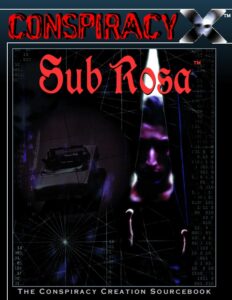“Three may keep a secret… if two of them are dead.”
– Benjamin Franklin, Poor Richard’s Almanack
 While Conspiracy X is best known for its setting focused on humanity’s ongoing struggle against aliens, monsters, and the supernatural, perhaps its most intriguing notion – its diamond hidden in the rough, so to speak – is its exploration into the very concept of ‘conspiracy’ itself. Sub Rosa: The Conspiracy Creation Sourcebook, is the game’s deep dive into this very subject, a supplement that aims to present a theoretical examination of how conspiracies come about, how they are run, and most importantly how they are created within the Conspiracy X ruleset.
While Conspiracy X is best known for its setting focused on humanity’s ongoing struggle against aliens, monsters, and the supernatural, perhaps its most intriguing notion – its diamond hidden in the rough, so to speak – is its exploration into the very concept of ‘conspiracy’ itself. Sub Rosa: The Conspiracy Creation Sourcebook, is the game’s deep dive into this very subject, a supplement that aims to present a theoretical examination of how conspiracies come about, how they are run, and most importantly how they are created within the Conspiracy X ruleset.
But just how well does it succeed in this task? Do we get nothing more than a shallow look at the same old tired conspiracies we see in so many other game lines, or will it break the shackles and truly deliver a sourcebook that allows Game Masters to build brand new layers of intrigue into their existing campaigns? Well, dear reader, read on and we shall find out…
This review is written with the assumption that the reader is already familiar with the setting and themes of Eden Studio’s Conspiracy X roleplaying game (or Con X as it is often abbreviated). For those of you who may not be familiar with the game or its setting, the ‘back of a napkin’ summary would be – the players usually assume roles as agents within AEGIS, a clandestine organisation tasked with hiding the truth of aliens, monsters and the supernatural from the fragile minds of humanity. In other words, think the X Files, but where you’re working for the Cigarette Smoking Man rather than alongside Mulder or Scully!
About the Book
 Sub Rosa was published in 1999 and was the last of the original tranche of 1st Edition supplements released in rapid succession during a period of about three years after the core rulebook’s first publication1. Coming in at a hefty 160 pages, it has the same high level of design, layout, and art as you’d come to expect in all Con X products, and except for the colour cover, all text and interior images are black and white2.
Sub Rosa was published in 1999 and was the last of the original tranche of 1st Edition supplements released in rapid succession during a period of about three years after the core rulebook’s first publication1. Coming in at a hefty 160 pages, it has the same high level of design, layout, and art as you’d come to expect in all Con X products, and except for the colour cover, all text and interior images are black and white2.
As with a few of the other 1st edition releases, Sub Rosa remains available in electronic format (via DrivethruRPG), although tracking down a physical copy is a little more difficult, as it is one of the more expensive (and harder to find) Con X supplements.
The book itself is divided into six chapters3, most of which focus on the mechanical processes of creating secret societies and conspiratorial organisations using the Conspiracy X 1st edition mechanics. Interestingly, the supplement breaks away slightly from others in the line, as rather than having a short piece of fiction gracing the start of each chapter (as was common in 90s roleplaying game books and which often combined tell a longer narrative based on the theme of the product), here the majority of the creative prose is collected at the beginning of Chapter Two (with only one other small piece found in the opening of Chapter One). Given the topics covered in Sub Rosa, this doesn’t feel too out of place, and while the presence of such long-form fiction does make the chapter drag a bit, it is nice to see the text – formatted as if it was a speech on ‘the nature of conspiracies’ – given some time to wind its way through the various topics so intimately relevant to the supplement.
The Breakdown
 After a short piece of fiction, the first chapter of Sub Rosa – labelled Anatomy – introduces the purpose of the supplement: to bring new secret societies into the world of Conspiracy X. It then overviews the book’s structure as well as discusses how the reader might get the best out of its contents. A short ‘Recommended Reading’ list is also provided, and although none of the books noted here immediately leap out as ‘must reads’, it looks as if all of these would add to a Game Master’s tool kit as they embark on the process of creating and bringing-to-life hidden societies.
After a short piece of fiction, the first chapter of Sub Rosa – labelled Anatomy – introduces the purpose of the supplement: to bring new secret societies into the world of Conspiracy X. It then overviews the book’s structure as well as discusses how the reader might get the best out of its contents. A short ‘Recommended Reading’ list is also provided, and although none of the books noted here immediately leap out as ‘must reads’, it looks as if all of these would add to a Game Master’s tool kit as they embark on the process of creating and bringing-to-life hidden societies.
As mentioned, Chapter Two, Nature, details a speech on the disposition of various ‘real world’ and fictional conspiracies, highlighting how they act, how they find purpose and whether or not such things could continue to exist in modern times (recalling, of course, that this book is set at the end of the last millennium). Reading this some 20-odd years after it was written, the speech incorporates several theories and conspiracies that have long been debunked in the age of the internet, and this to some extent undermines the entire presentation, but never really invalidates it. Given, of course, its context as existing in a fictional roleplaying game about maintaining a ‘bodyguard of lies’ around conspiracies, it is a ‘nod and wink’ towards the very heart of Conspiracy X, and will still give the reader something to smile about.
Of likely more interest is the material that follows the fiction, where the book’s authors outline the distinct difference between secret societies and conspiracies, as well as their allure and how such groups can survive hidden – often in plain sight – in a setting such as Con X. One can only but nod along at some of the idiosyncrasies raised in these few pages, especially at the very nature of what a conspiracy really is and the statement that the idea of ‘conspiracy is so good, it would need to be invented if it did not already exist’.
The chapter rounds out with a paragraph on how to incorporate secret societies into Conspiracy X and explains that they are equally at home embedded in existing organisations, such as AEGIS, The National Defence Directorate (AEGIS’ government-sponsored rival) or as entirely new entities outside anything that might already be present in the game.
Chapter Three – Conception – details the process of creating a secret society, and it is here that we can see why this supplement was so well regarded by gamers at the time of its release – even for those not playing Conspiracy X. Presented in a structured, yet flexible, format, the text leads the reader through a series of steps that will ultimately generate the core structure, membership, and even the relationships of a brand, new secret society.
Here we get questions that the Game Master (perhaps in conjunction with their players) should answer as they work through the process, and one can easily imagine the fun you could have completing this at the gaming table. Everything is covered here, from selecting the society’s ‘makeup’ (i.e. are they academics, a cult, or a paramilitary group – among dozens of other choices) through to what outward identity – public, covert, shadowy, etc. – the society and members take on? Each of these selections provides the conspiracy with new resources to tap into while also funnelling them through to further specific choices.
 With the group’s makeup in place, the next set of decisions are made around the organisation’s power structure, the territory under its control and its size. These elements combined with its resources (i.e. who funds/supports the conspiracy, and how much of this influence it can bring to bear) form the backbone of the secret society and help to answer further questions. Following this process you can define the group’s sphere of influence, how loyal are its members, and just what/how many connections or resources can it dedicate to its cause (including what support can it call on from other – likely more legitimate – organisations; abilities known as ‘pulling strings in Con X).
With the group’s makeup in place, the next set of decisions are made around the organisation’s power structure, the territory under its control and its size. These elements combined with its resources (i.e. who funds/supports the conspiracy, and how much of this influence it can bring to bear) form the backbone of the secret society and help to answer further questions. Following this process you can define the group’s sphere of influence, how loyal are its members, and just what/how many connections or resources can it dedicate to its cause (including what support can it call on from other – likely more legitimate – organisations; abilities known as ‘pulling strings in Con X).
Finally, these steps culminate in determining the meta-game purpose for the conspiracy to exist within the player-characters narrative (i.e. what is the actual reason for this new group to appear in your Con X games). As always, we are provided with a good dozen or so examples of why this might be (and I can think of a few more immediately!) ranging from the tangential (e.g. the society has resources the characters will need to access – a library or record archives for example) – through to more confrontational possibilities (e.g. the group is in opposition to or allied with one of the game setting’s main players, AEGIS or The National Defence Directorate).
As you can see, these questions and decisions create a comprehensive series of stage gates for building your new secret society, a process that generates a well-fleshed-out ally or opponent from the moment they hit play.
The next chapter – Organs – dedicates itself to new and enhanced character professions. Given the increased scope of the Conspiracy X setting presented in this book, especially when compared with what was previously available, it makes sense that individuals from a lot more diverse backgrounds can be drawn into secret societies or underground conspiracies. While page after page of Profession descriptions doesn’t make for the most exciting reading experience, you can see here the genesis of the setting that most players would now imagine when they think of Conspiracy X. Let’s be honest, the limited number of professions presented in the original rulebook (even with the few additions sprinkled in from other supplements) did always felt too limited, and this chapter very much feels like a complete reset of this part of the game’s character creation process.
Along with the increased scope of professions, there is also the need to reintroduce the concept of ‘Infrastructures’ (i.e. the businesses, organisations, government departments, etc. within which the careers exist). Not only does this provide the reader with some idea of the various types of organisations that can become secret societies but also how such groups carve out their unique niche and influence other factions into supporting their end goals. This is a nice summary and again gives the Game Master a shopping list of additional ideas that I’m sure will inspire them to build a better, more complex setting for their players.
 This leads us to Chapter Five – Capacities– the longest section of the supplement. Here we are introduced to a new and improved character creation process (one that will be the default for Con X moving forward), which is used to better reflect the scope of the game now that there is the opportunity to use groups beyond AEGIS as the player’s base of power.
This leads us to Chapter Five – Capacities– the longest section of the supplement. Here we are introduced to a new and improved character creation process (one that will be the default for Con X moving forward), which is used to better reflect the scope of the game now that there is the opportunity to use groups beyond AEGIS as the player’s base of power.
This mostly focuses on expanding the number and scope of ingame character-facing mechanics such as Traits, ‘Pulling Strings’, and other abilities and while these are mostly well-considered additions to the game, the most important change, at least in my opinion are the changes to the Influence attribute.
Introduced in the core rulebook, Influence represents an individual’s level of authority and their ability to activate any ‘Pulling Strings’ abilities. To better reflect the dichotomy of characters having to operate both in public and as members of secret societies, Sub Rosa splits the attribute into two separate categories – Overt Influence and Covert Influence. These two statistics are used to differentiate how a character’s power and reputation might differ between their ‘day job’, versus that which they can have in their secret society. Here again, we get a really simple mechanic that enables more complex play without overwhelming the players or the game with detailed mechanics.
The final chapter – Tumor – can be thought of as the culmination of everything presented in this supplement so far, as it details ten well-thought-out and ready-to-use secret societies. Interestingly some of these examples are groups previously introduced in earlier Con X sourcebooks, a callback that does a lot to support the idea that all of Conspiracy X is connected as one living, breathing world (as opposed to being a collection of disparate concepts total divorced from each other, i.e. a Game Master must run monster hunting-style stories in one way and those dealing with the machinations of the ET races in another). Better yet, the samples provided here aren’t just some quick, half-paragraph write-ups, but rather are detailed and unique deep dives into each society’s history, motivations, and secrets (with the shortest of these coming in at around 1500 words).
As it would be unfair to spoil all these wonderful ideas, I will limit my discussion to just one of my favourites – People United for the Protection of Peaceful Extra Terrestrials (or PUPPET). This group is a society dedicated to revealing the truth behind the global cover-up of the existence of aliens. As one might expect, these individuals are willing to go to various extremes to achieve their goals. Of course, the question then is, who do they actually work for, and just what do they expect to achieve after the truth is revealed?
That’s what makes, at least in my opinion, this group such an interesting secret society. Add in the fact they have (or at least had) in their possession a real Grey ET corpse, as well as parts of a down saucer, and you start to wonder just who is behind this group and what their ultimate goal might be. You know, just writing up this part of the review inspires more than a couple of adventure ideas using this group…
And with all those creative juices now bubbling up, the book comes to a close with a brief Appendix, a simple conversion of a few AEGIS-specific mechanics (introduced in the AEGIS Handbook) into the same format as those outlined in this supplement (which makes sense, AEGIS is just another conspiracy, right?).
My overall thoughts?
 This is a difficult one for me. On the one hand, Sub Rosa does a lot to break the shackles of Conspiracy X away from its ‘traditional’ framing structure – one where the characters play only agents of AEGIS and face off against the three extra-terrestrial races and their human allies. However, on the other, it is a book that dedicates about half its page count exclusively to new rules and detailed mechanics for the game’s 1st Edition (which I don’t think anyone uses anymore). Don’t get me wrong, everything about the process of creating secret societies is fantastic and well worth the read4 but just so much of its content is focused on the mechanics, that it seems to overwhelm the other – system agnostic – ideas.
This is a difficult one for me. On the one hand, Sub Rosa does a lot to break the shackles of Conspiracy X away from its ‘traditional’ framing structure – one where the characters play only agents of AEGIS and face off against the three extra-terrestrial races and their human allies. However, on the other, it is a book that dedicates about half its page count exclusively to new rules and detailed mechanics for the game’s 1st Edition (which I don’t think anyone uses anymore). Don’t get me wrong, everything about the process of creating secret societies is fantastic and well worth the read4 but just so much of its content is focused on the mechanics, that it seems to overwhelm the other – system agnostic – ideas.
Yes, the standout is absolutely the various example conspiracies outlined in Chapter Six, and I love the way that these harken back to previous supplements, but would or could I recommend someone buys a copy of this book just for that material… unfortunately, no. (In fact, I’d point them to the 2nd Edition Conspiracies Sourcebook – as this covers everything touched upon in Sub Rosa, and much more besides!)
Still, this book will always have a special place in my RPG heart, as it introduced me to just how you can always take the core idea for a game and remix it – often creating a more interesting and exciting variation – without breaking it completely, and for that I am grateful!
Recommended for crazed Conspiracy X fans or die-hard collectors only!
- Sub Rosa being the 15th core release for the line in that period, while it would not see another full supplement for another three years, with 2002’s The Hand Unseen), ↩
- While this might not match the aesthetic we set for our gaming products today, the upside of this simple design is that its content is always eminently readable. ↩
- In addition to a small appendix and comprehensive index. ↩
- Seriously, I’ve played in and read numerous games that attempt to provide similar structures, and this one is by far the most comprehensive and inspiring! ↩


Leave a Reply